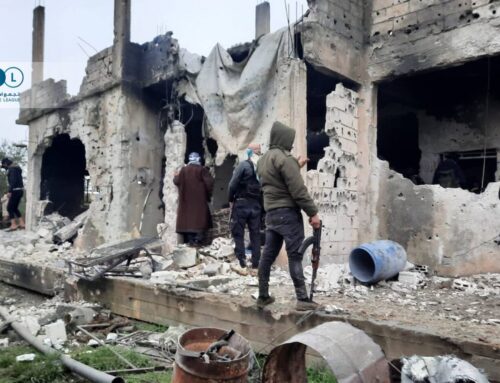In a small but strategic mountain village, residents are ordered to leave
For the second time in less than a month, regime […]
10 August 2016
For the second time in less than a month, regime and Hezbollah forces have expelled hundreds of families from a village in the Qalamoun mountains.
The village of Hurayra links rebel-held territory in the Wadi Barada region with the rebel-held and regime-encircled towns of Madaya and Zabadani—the starting point of Hezbollah-managed smuggling routes to neighboring Lebanon.
On Saturday, government-allied soldiers with loudspeakers informed the residents of Hurayra, roughly 30km northwest of Damascus, that they had 24 hours to evacuate their homes.
At 12:00pm Sunday, the pro-regime fighters entered the village and “expelled between 200 and 220 families,” an activist who fled Hurayra and is now in an undisclosed location in the suburbs of Damascus tells Syria Direct’s Waleed a-Noufal.
The expelled residents were allowed to go to either regime or opposition territory and to “carry small handbags with their belongings,” said the activist.
On July 17, the soldiers surrounding Hurayra issued a similar 24-hour deadline and 400 families left, Syria Direct reported. Following the first expulsion of Hurayra’s residents, fighters with Jabhat al-Nusra retaliated by executing 12 regime captives in a video circulated on social media.
The families who remained after the July incident were “related to draft dodgers or opposition fighters,” the activist told Syria Direct on July 20. Of the village’s 800 original families, only those with government affiliations have been allowed to remain.
Q: What is the latest from Hurayra? How many families have left?
On Saturday regime forces gave Hurayra’s citizens a 24-hour deadline to evacuate their village. The regime told the population they were permitted to go anywhere—regime or opposition territory—as long as they left.
The deadline expired at 12:00pm on Sunday. At that exact moment, the regime and Hezbollah forces entered the village and expelled between 200 and 220 families from the village.
They left for the villages of Wadi Barda, the village of Rankous and the Qalamoun mountains. Additionally, a small segment of the population sought shelter in regime-held regions.

Q: What did regime forces do after entering Hurayra?
The regime’s displacement methods were severe. Regime and Hezbollah forces in Hurayra used the same strategies of displacement that they used in Zabadani. First they warned the citizens to leave, then they expelled them.
On Monday, after the remaining few hundred families had left, regime-allied forces began ransacking homes in the village and looting them. They stole sink faucets, home furnishings and household supplies. They stripped homes to sell their contents. After the looting, the soldiers placed explosives inside the homes. They burned and blew up the homes on the village’s periphery.
Some families were permitted to remain in the village. Those with sons in the army, security forces or those with sons who had been killed fighting alongside the regime, were all given permission to stay. Everyone else was forced to leave. Those with family members wanted for conscription or those with family members who had previously joined the opposition—all of them were forced to leave. The regime allowed them to move to any area, either regime- or rebel-controlled territory.
Q: Were people allowed to take their goods with them? Did the regime give them a specific time to return?
Regime forces allowed each person to take small bags of belongings. However, they forbade citizens from taking their home furnishings or any electrical appliances with them.
The regime didn’t inform people when they could return.
In many areas where people have been displaced, Zabadani for example, there have been repeated attempts to return but none have been successful.
The regime didn’t give any monetary compensation for the property people lost. Given that the regime is pushing for demographic change in the area, why would it?
Hurayra is on a geographic line linking the western Qalamoun mountains and Wadi Barada, but it also links the western Qalamoun mountains from Zabadani and Madaya. The regime wants to end the possibility of contact between opposition forces in these areas.
Q: What has been the fate of people pushed out of their homes?
Most of the families driven out of Hurayra fled to the villages of Wadi Barada. They’ve been reduced to abject poverty; they are eating food from the fields. Most people are living five families to a single home.







